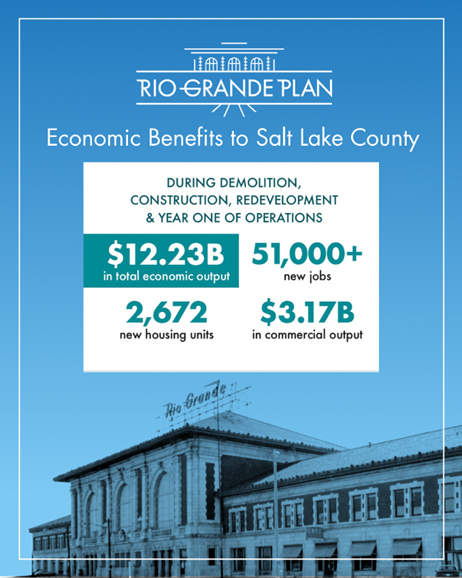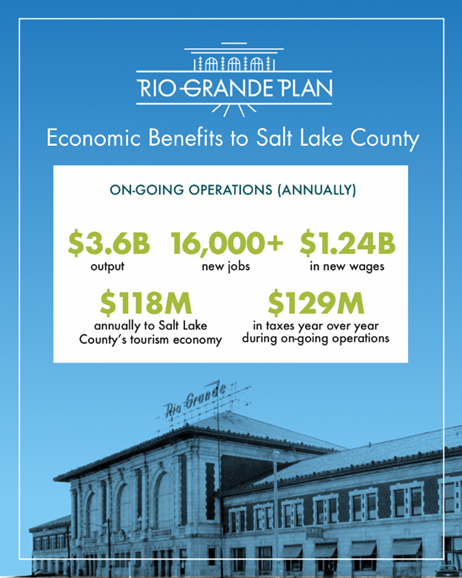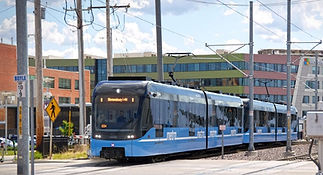Once the pride of western rail, Salt Lake City’s Rio Grande Depot saw its last train depart nearly 30 years ago. A “temporary” track shift for the 2002 Winter Olympics swerved trains away from the Depot to the city’s edge and they never came back. Today, a bold, citizen-led plan is aiming to bring trains home to the downtown icon and at the same time solve transportation problems that have divided the city for generations.

Finding Purpose in the Pandemic by Dreaming Big
In March 2020, as the COVID pandemic shut down daily life and an earthquake caused tens of millions in damage to the historic Rio Grande Depot, local landscape architect Cameron Blakely noticed an intriguing idea on an online city planning forum. The proposal was to realign the railroad tracks downtown and restore service to the old Depot. It came from Christian Lenhart, a local civil engineer.
Christian’s interest in the topic had started years earlier while working as a host on Utah’s commuter train, the FrontRunner. There, he saw firsthand how confused and disappointed people were when they got off at Salt Lake Central Station. Its distance from downtown and lack of basic amenities like food, shelter, and bathrooms have given it an underwhelming, temporary feel since the day it opened. In his spare time, Christian started brainstorming ways to realign the tracks and restore service to the Rio Grande Depot, posting anonymously to online forums for feedback.

After reading Christian’s posts, Cameron, who had a background in urban and railyard planning, sent him a message offering his help and the two spent the summer of 2020 virtually collaborating on designs. “Peak pandemic, we were all looking for a bit of purpose,” Cameron remembers, “Ways of getting engaged in something, or if nothing else finding a distraction.”

Together they came up with the Rio Grande Plan. Inspired by projects like the Reno Train Trench and the Denver Union Station renovation, their plan restored the track alignment to the Rio Grande Depot, but under the existing city street in a “train box,” essentially a train trench with a lid. Like in Denver, funding for the project would come primarily from developing the underutilized rail yards after the tracks were moved.

They put together materials and visuals and posted the idea online to a burst of immediate interest. As conversations grew, Christian and Cameron realized the benefits of their proposal went far beyond reconnecting to the Depot. It could in fact solve what one Salt Lake City transportation planner called, “the single largest transportation issue in the city.” For over 150 years freight and passenger trains have cut through the heart of Salt Lake City at several at-grade crossings, creating major safety hazards and stalling economic growth west of the tracks. This “train box” idea would reconnect neighborhoods, boost growth, and make the city safer.

Key Studies Prepared as Salt Lake City sees Potential
Seeing the plan’s overwhelming potential, in 2022 Salt Lake City hired engineering firm Kimley-Horn to study the Rio Grande Plan. They spoke with stakeholders, confirmed its feasibility, expanded the scope, and estimated the cost at $3–5 billion. Though a higher cost than expected, the expanded plan would unlock up to 75 acres for redevelopment, offering even greater economic benefits to the city and state.
In 2023, Salt Lake City secured a $3 million federal grant from the Reconnecting Communities Program to study the city’s East/West divide and explore possible solutions. The Rio Grande Plan is the most complete solution, but it will only move forward in this process if the public gets involved and speaks up in support. The results of this study could prove invaluable in opening the door to federal support.
Recent Study shows Astounding Economic Benefits
In April 2025, Utah State University released the results of an economic impact analysis that finally quantified the economic benefits of the Rio Grande Plan. With huge economic gains that go well beyond the construction phase, the numbers confirm that the benefits far outweigh the $3-5 Billion cost. As Curtis Bishop, a graduate student at Utah State University who played a key role in the study, put it “with these numbers in mind… this seems like a screaming deal to me.”
What’s Next?
With the costs and benefits in hand, the newly organized non-profit Via Rio Grande hopes to work with local, state, and federal officials to identify funding sources that could make transit projects across the Wasatch Front, including the Rio Grande Plan, a reality by the time Salt Lake City hosts the 2034 Winter Olympics. They also continue to ask that citizens reach out to their elected officials and tell them they want the Rio Grande Plan built prior to the 2034 Olympics. The timing would be poetic since it was the 2002 Winter Olympics that pulled rail service away from the Depot in the first place.
How could other projects do the same?
Identify the Issue and Clearly Deliver the Solution
Christian identified the problem through his personal experiences on the FrontRunner. His civil engineering background and Cameron’s design expertise enabled them to create a solution. Together they refined the proposal and distilled their ideas into concise explanations with eye-catching visuals.
Make Connections
While every transit project is unique, they all have a shared ingredient in success: connection. Which makes sense because transit is all about connecting people. The Rio Grande Plan came to life through connections: many citizens uniting around a shared idea, building relationships with city, state, and federal leaders, and drawing inspiration from successful projects across the country.
Show the Economic Benefit
Amtrak Board Member Elaine Clegg recently emphasized that rail infrastructure projects need to happen in a way that makes sense economically for the local communities. The Rio Grande Plan has momentum because it does exactly that. By placing tracks more efficiently, the plan unlocks major development opportunities and reconnects divided neighborhoods, boosting local businesses, property values, and even public health.
In addition, moving to a well-designed, well-placed station builds on this impact: increasing property values, attracting tourists, driving foot traffic, and encouraging more people to choose transit over driving. This in turn will ease traffic, reduce parking needs, improve air quality, cut accidents, and lower the need for costly freeway expansions.
These benefits can be quantified and used to demonstrate the benefits of a citizen-proposed transit plan.

Find a Precedent
Real-world examples build confidence. Variations of the same challenges people face in their neighborhoods, cities, and states can likely be found in other places. Both the Denver Union Station renovation and the Reno Train Trench were solutions to problems like the ones faced in Salt Lake City. Studying them as proven solutions inspired the Rio Grande Plan, and being able to point to their success has made it much easier to explain and build support.
Get Involved
Consider how you can contribute the “Four T’s:” time, talent, treasures, and ties. Attend public meetings at the community, regional, and state level and those held by your public transit authorities. Utah, for example, has the Utah Transit Authority (UTA), Utah Department of Transportation (UDOT), and the Wasatch Front Regional Council. Most of those meetings allow citizens to make a public comment. Although it can be tough to make your first comment it gets easier and can even be fun! Just remember to always stay respectful.
Organizations like All Aboard Ohio and Via Rio Grande need your time at booths, in public meetings, and advocating for projects. They also need fresh perspectives and skills. Your unique talents could help fill a gap they didn’t even realize existed. If you see an opportunity to help, step up! Most organizations will be incredibly grateful for new energy and ideas. Building connections that help move projects forward is another powerful way to contribute. And if you’re able, financial donations are always vital to keep these efforts growing.
Don’t Stop Talking About It
Contact your city, county, state, and federal elected officials and tell them you want a specific plan. Handwritten letters can have a powerful impact, but emails and phone calls are also great tools to get your voice heard. If you don’t hear back, don’t hesitate to follow up with them. Officials juggle many demands and a respectful reminder can help keep the conversation moving forward.
Promote these organizations by sharing their work with friends, family, neighbors, and even strangers. You never know if someone you meet in your day-to-day life could be someone who could change the course of the project. So, speak often about the projects going on in your community and help spread the word. Ideas only die when people stop talking about them. Keep the conversation alive and help the ideas become reality by staying engaged, staying vocal, and encouraging others to do the same.
Thank you to All Aboard Ohio for inviting us to share about the Rio Grande Plan! To find out more about about it, visit riograndeplansaltlakecity.org
Brittany Knudson and Frederick Jenny
Brittany and Frederick are guest bloggers from Via Rio Grande, a nonprofit advocating for Salt Lake City to expand passenger rail
ABOUT ALL ABOARD OHIO
All Aboard Ohio is a non-profit, member-based organization dedicated to promoting improved public transportation and passenger rail service throughout the state.
Founded in 1973 and incorporated as a registered 501c-3 in 1987, All Aboard Ohio has spent more than 50 years advocating, educating, and working towards our goal of a connected Midwest
All Aboard Ohio is a 501c-3 nonprofit with over 50 years of advocacy work, advocating for improved public transportation and passenger rail service in the Midwest
©2025 by All Aboard Ohio
Get in Touch
3136 Kingsdale Center,
#112 Columbus, OH 43221
Federal Tax ID: 31-1066182













